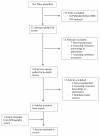Calorie menu labeling on quick-service restaurant menus: an updated systematic review of the literature
- PMID: 22152038
- PMCID: PMC3254594
- DOI: 10.1186/1479-5868-8-135
Calorie menu labeling on quick-service restaurant menus: an updated systematic review of the literature
Abstract
Nutrition labels are one strategy being used to combat the increasing prevalence of overweight and obesity in the United States. The Patient Protection and Affordable Care Act of 2010 mandates that calorie labels be added to menu boards of chain restaurants with 20 or more locations. This systematic review includes seven studies published since the last review on the topic in 2008. Authors searched for peer-reviewed studies using PUBMED and Google Scholar. Included studies used an experimental or quasi-experimental design comparing a calorie-labeled menu with a no-calorie menu and were conducted in laboratories, college cafeterias, and fast food restaurants. Two of the included studies were judged to be of good quality, and five of were judged to be of fair quality. Observational studies conducted in cities after implementation of calorie labeling were imprecise in their measure of the isolated effects of calorie labels. Experimental studies conducted in laboratory settings were difficult to generalize to real world behavior. Only two of the seven studies reported a statistically significant reduction in calories purchased among consumers using calorie-labeled menus. The current evidence suggests that calorie labeling does not have the intended effect of decreasing calorie purchasing or consumption.
Similar articles
-
Nutritional labelling for healthier food or non-alcoholic drink purchasing and consumption.Cochrane Database Syst Rev. 2018 Feb 27;2(2):CD009315. doi: 10.1002/14651858.CD009315.pub2. Cochrane Database Syst Rev. 2018. PMID: 29482264 Free PMC article.
-
The influence of menu labeling on calories selected or consumed: a systematic review and meta-analysis.J Acad Nutr Diet. 2014 Sep;114(9):1375-1388.e15. doi: 10.1016/j.jand.2014.05.014. Epub 2014 Jul 16. J Acad Nutr Diet. 2014. PMID: 25037558
-
A Systematic Review of Calorie Labeling and Modified Calorie Labeling Interventions: Impact on Consumer and Restaurant Behavior.Obesity (Silver Spring). 2017 Dec;25(12):2018-2044. doi: 10.1002/oby.21940. Epub 2017 Oct 17. Obesity (Silver Spring). 2017. PMID: 29045080 Free PMC article.
-
The influence of menu labelling on food choices among children and adolescents: a systematic review of the literature.Perspect Public Health. 2017 May;137(3):173-181. doi: 10.1177/1757913916658498. Epub 2016 Jul 19. Perspect Public Health. 2017. PMID: 27436235
-
Impact of calorie labelling on online takeaway food choices: An online Menu-Based Choice Experiment in England.Appetite. 2025 Mar 1;207:107894. doi: 10.1016/j.appet.2025.107894. Epub 2025 Feb 3. Appetite. 2025. PMID: 39909208 Clinical Trial.
Cited by
-
Sodium menu labelling: priorities for research and policy.Public Health Nutr. 2021 Apr;24(6):1542-1551. doi: 10.1017/S1368980020003961. Epub 2020 Oct 9. Public Health Nutr. 2021. PMID: 33032669 Free PMC article. Review.
-
Calorie labeling, fast food purchasing and restaurant visits.Obesity (Silver Spring). 2013 Nov;21(11):2172-9. doi: 10.1002/oby.20550. Epub 2013 Oct 17. Obesity (Silver Spring). 2013. PMID: 24136905 Free PMC article.
-
CVD Prevention Through Policy: a Review of Mass Media, Food/Menu Labeling, Taxation/Subsidies, Built Environment, School Procurement, Worksite Wellness, and Marketing Standards to Improve Diet.Curr Cardiol Rep. 2015 Nov;17(11):98. doi: 10.1007/s11886-015-0658-9. Curr Cardiol Rep. 2015. PMID: 26370554 Free PMC article. Review.
-
Effects of physical activity calorie expenditure (PACE) labeling: study design and baseline sample characteristics.BMC Public Health. 2017 Sep 12;17(1):702. doi: 10.1186/s12889-017-4710-0. BMC Public Health. 2017. PMID: 28899366 Free PMC article. Clinical Trial.
-
A Meta-Analysis to Determine the Impact of Restaurant Menu Labeling on Calories and Nutrients (Ordered or Consumed) in U.S. Adults.Nutrients. 2017 Sep 30;9(10):1088. doi: 10.3390/nu9101088. Nutrients. 2017. PMID: 28973989 Free PMC article.
References
-
- Variyam JN. Nutrition labeling in the food-away-from-home sector: an economic assessment. Economic Research Report Number 4. 2005. http://www.ers.usda.gov/Publications/ERR4/ Accessed November 25, 2011.
Publication types
MeSH terms
LinkOut - more resources
Full Text Sources
Medical


